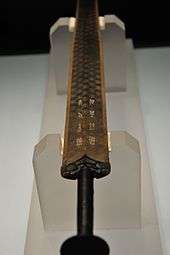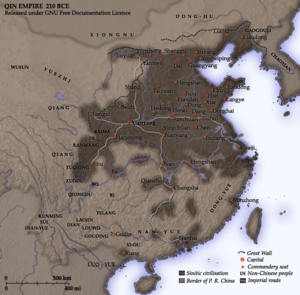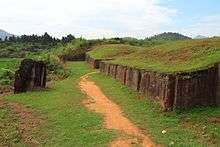Baiyue
| Baiyue | |||||||||||||||||||||||||||||||||||||||
 Statue of a man, from the state of Yue | |||||||||||||||||||||||||||||||||||||||
| Chinese name | |||||||||||||||||||||||||||||||||||||||
|---|---|---|---|---|---|---|---|---|---|---|---|---|---|---|---|---|---|---|---|---|---|---|---|---|---|---|---|---|---|---|---|---|---|---|---|---|---|---|---|
| Chinese | 百越 | ||||||||||||||||||||||||||||||||||||||
| |||||||||||||||||||||||||||||||||||||||
| Vietnamese name | |||||||||||||||||||||||||||||||||||||||
| Vietnamese | Bách Việt | ||||||||||||||||||||||||||||||||||||||
| Zhuang name | |||||||||||||||||||||||||||||||||||||||
| Zhuang | Bakyez | ||||||||||||||||||||||||||||||||||||||
The Baiyue, Hundred Yue or Yue were various partly or un-Sinicized peoples who inhabited South China and northern Vietnam between the first millennium BC and the first millennium AD.[1][2] In the Warring States period, the word "Yue" referred to the State of Yue in Zhejiang. The later kingdoms of Minyue in Fujian and Nanyue in Guangdong are both considered Yue states. Although Yue people had knowledge of agriculture and the technology of shipbuilding, Chinese writers depicted the Yue as barbarians who had tattoos, lived in primitive conditions, and lacked such technology as bows, arrows, horses and chariots.
The Yue were assimilated or displaced as Chinese civilization expanded into southern China in the first half of the first millennium AD. Many southern varieties of Chinese bear traces of substrate languages originally spoken by the Yue. Variations of the name are still used in the name of Vietnam, in Zhejiang-related names including Yue Opera, and in the abbreviation for Guangdong.
Name
The modern term "Yue" (Chinese: 越 or 粵; pinyin: Yuè; Cantonese Yale: Yuht; Wade–Giles: Yüeh4; Vietnamese: Việt; Zhuang: Vot; Early Middle Chinese: Wuat) comes from Old Chinese *wjat.[3] It was first written using the pictograph "戉" for an axe (a homophone), in oracle bone and bronze inscriptions of the late Shang dynasty (c. 1200 BC), and later as "越".[4] At that time it referred to a people or chieftain to the northwest of the Shang.[1] In the early 8th century BC, a tribe on the middle Yangtze were called the Yángyuè, a term later used for peoples further south.[1] Between the 7th and 4th centuries BC "Yue" referred to the State of Yue in the lower Yangtze basin and its people.[1][4]
The term "Hundred Yue" first appears in the book Lüshi Chunqiu compiled around 239 BC.[5] It was used as a collective term for the non-Chinese populations of south and southwest China and northern Vietnam.[1]
Ancient texts mention a number of Yue states or groups. Most of these names survived into early imperial times:
| Chinese | Mandarin | Cantonese (Jyutping) | Zhuang | Vietnamese | Literal English trans.: |
|---|---|---|---|---|---|
| 於越/于越 | Yūyuè | jyu1 jyut6 | Ư Việt | Yue | |
| 揚越/扬越 | Yángyuè | joeng4 jyut6 | Dương Việt | Yang Yue | |
| 干越 | Gānyuè | gon3 jyut6 | Cán Việt | Gan Yue | |
| 閩越/闽越 | Mǐnyuè | man5 jyut6 | Mân Việt | River Yue | |
| 夜郎 | Yèláng | je6 long4 | Dạ Lang | Night Yue | |
| 南越 | Nányuè | naam4 jyut6 | Namzyied | Nam Việt | Southern Yue |
| 山越 | Shānyuè | saan1 jyut6 | Sơn Việt | Mountain Yue | |
| 雒越 | Luòyuè | lok6 jyut6 | Lạc Việt | Sea Bird Yue | |
| 甌越/瓯越 | Ōuyuè | au1 jyut6 | Âu Việt | (East) Valley Yue | |
| 滇越,盔越 | Diānyuè, Kuīyuè | din1 jyut6, kwai1 jyut6 | Điền Việt, Khôi Việt | Heavenly Yue, Basin Yue |
Peoples of the lower Yangtze

In the 5th millennium BC, the lower Yangtze area was already a major population centre, occupied by the Hemudu and Majiabang cultures, who were among the earliest cultivators of rice. By the 3rd millennium BC, the successor Liangzhu culture shows some influence from the Longshan-era cultures due to trade and commerce.[6] However, a high frequency of O1 was found in Liangzhu culture sites, linking it to modern Austronesian and Daic populations.[7]
From the 9th century BC, two northern Yue peoples, the Gou-Wu and Yu-Yue, were increasingly influenced by their Chinese neighbours to their north. These two states were based in the areas of what is now southern Jiangsu and northern Zhejiang respectively. Their aristocratic elite learned the written Chinese language and adopted Chinese political institutions and military technology. Traditional accounts attribute the cultural change to Taibo of Wu, a Zhou prince who had self-exiled to the south. The marshy lands of the south gave Gou-Wu and Yu-Yue unique characteristics. They did not engage in extensive agrarian agriculture, relying instead more heavily on aquaculture. Water transport was paramount in the south, so the two states became advanced in shipbuilding and developed riverine warfare technology. They were also known for their fine swords.
In the Spring and Autumn period, the two states, now called Wu and Yue, were becoming increasingly involved in Chinese politics. According to the Han historian Sima Qian, King Goujian of Yue was descended from the legendary Yu the Great.[8] In 512 BC, Wu launched a large expedition against the large state of Chu, based in the Middle Yangtze River. A similar campaign in 506 succeeded in sacking the Chu capital Ying. Also in that year, war broke out between Wu and Yue and continued with breaks for the next three decades. In 473 BC, King Goujian of Yue finally conquered Wu and was acknowledged by the northern states of Qi and Jin. In 333 BC, Yue was in turn conquered by Chu.[9] After the fall of State of Yue, the ruling family moved south to what is now Fujian and established the Minyue kingdom.
Sinification and displacement

After the unification of China by Qin Shi Huang, the former Wu and Yue states became incorporated into the Chinese empire. The Qin armies also advanced south along the Xiang River to modern Guangdong and set up commanderies along the main communication routes. "In the south he seized the land of the hundred tribes of the Yue and made of it Guilin and Xiang provinces, and the lords of the hundred Yue bowed their heads, hung halters from their necks, and pleaded for their lives with the lowest officials of the Qin," wrote Sima Qian.[10]
The "Treatise of Geography" in the Book of Han (completed AD 111) describes the Yue lands as stretching from Shaoxing on the southern shore of Hangzhou Bay to Jiaozhi in modern north Vietnam.[9] Throughout the Han dynasty period two groups of Yue were identified, that of the Nanyue in the far south, who lived mainly in the area of what is now Guangdong, Guangxi, and Vietnam; and that of the Minyue to the southeast, centred on the Min River in modern Fujian.
The kingdom of Nanyue was founded at the collapse of the Qin dynasty in 204 BC by the local Qin commander Zhao Tuo. At its height, Nanyue was the strongest of the Yue states, with Zhao Tuo declaring himself emperor and receiving the allegiance of neighbouring kings.[11] The dominant ethnicities of this kingdom were the Han and Yue, who held all the most important positions in the kingdom.[12] Intermarriage was encouraged and was very common among the commoners, and it happened even in the royal family of Nanyue, the last king was descendant of Han and Yue. The kingdom of Nanyue was destroyed in 111 BC by an army of Emperor Wu of Han.
Sinification of these peoples was brought about by a combination of imperial military power, regular settlement and Chinese refugees. According to one Chinese immigrant of the second century BC, the Yue "cut their hair short, tattooed their body, live in bamboo groves with neither towns nor villages, possessing neither bows or arrows, nor horses or chariots."[13] The difficulty of logistics and the malarial climate in the south made the displacement and eventual sinification of the Yue peoples a slow process.
As Chinese migrants gradually increased, the Yue were gradually forced into poorer land on the hills and in the mountains. Unlike the nomadic peoples of Central Asia, such as the Xiongnu or the Xianbei, however, the Yue peoples never posed any serious threat to Chinese expansion or control. Sometimes they staged small-scale raids or attacks on Chinese settlements – termed "rebellions" by traditional historians.
Most Yue peoples were eventually sinicized, and continue to live in Zhejiang and Guangdong,[14][15] speakers of the Kam–Tai languages: Zhuang, Bouyei, Dai, Sui, Dong, Hlai, Mulam, Maonan (Anan), Ong Be, Thai, Lao, and Shan people retained their ethnic identities.
Language
Knowledge of Yue speech is limited to fragmentary references and possible loanwords in other languages, principally Chinese. The longest is the Song of the Yue Boatman, a short song transcribed phonetically in Chinese characters in 528 BC and included, with a Chinese version, in the Garden of Stories compiled by Liu Xiang five centuries later.[16]
There is some disagreement about the languages they spoke, with candidates drawn from the non-Sinitic language families still represented in areas of southern China, Tai–Kadai, Hmong–Mien and Austroasiatic. Chinese, Tai–Kadai, Hmong–Mien and the Vietic branch of Austroasiatic have similar tone systems, syllable structure, grammatical features and lack of inflection, but these features are believed have spread by diffusion across the Mainland Southeast Asia linguistic area, rather than indicating common descent.[17]
Jerry Norman and Mei Tsu-Lin presented evidence that at least some Yue spoke an Austroasiatic language:[4][18][19]
- Zheng Xuan (127–200 AD) wrote that 扎 (middle Chinese: "jaat", modern Mandarin Chinese zā, modern Sino-Vietnamese: "trát") was the word used by the Yue people (越人) to mean "die". Norman and Mei reconstruct this word as OC *tsət and relate it to Austroasiatic words with the same meaning, such as Vietnamese chết and Mon chɒt.
- According to the Shuowen Jiezi (100 AD), "In Nanyue, the word for dog is (Chinese: 撓獀; pinyin: náosōu; EMC: nuw-ʂuw)", possibly related to other Austroasiatic terms. Sōu is "hunt" in modern Chinese.
- The early Chinese name for the Yangtze (Chinese: 江; pinyin: jiāng; EMC: kœ:ŋ; OC: *kroŋ; Cantonese: "kong") was later extended to a general word for "river" in south China. Norman and Mei suggest that the word is cognate with Vietnamese sông (from *krong) and Mon kruŋ "river".
They also provide evidence of an Austroasiatic substrate in the vocabulary of Min Chinese.[4][20] Norman and Mei's hypothesis is widely quoted, but has recently been criticized by Laurent Sagart.[21]
Scholars in China often assume that the Yue spoke an early form of Tai–Kadai. The linguist Wei Qingwen gave a rendering of the "Song of the Yue boatman" in Standard Zhuang. Zhengzhang Shangfang proposed an interpretation of the song in written Thai (dating from the late 13th century) as the closest available approximation to the original language, but his interpretation remains controversial.[16][21]
Legacy

The fall of the Han dynasty and the succeeding period of division sped up the process of sinicization. Periods of instability and war in northern China, such as the Northern and Southern dynasties and during the Song dynasty led to mass migrations of Chinese.[22] Intermarriage and cross-cultural dialogue has led to a mixture of Chinese and non-Chinese peoples in the south.[23][24] Most of the distinctive features of vocabulary, phonology and syntax of southern varieties of Chinese are attributed substrate languages spoken by the Yue.[25][26] By the Tang dynasty (618–907), the term "Yue" had largely become a regional designation rather than a cultural one, as in the Wuyue state during the Five Dynasties and Ten Kingdoms period in what is now Zhejiang province.
In ancient China, the characters 越 and 粵 (both yuè in pinyin) were used interchangeably, but they are differentiated in modern Chinese:
- The character "越" refers to the original territory of the Yue Kingdom, based in present-day northern Zhejiang Province, especially the areas around Shaoxing and Ningbo. The Shaoxing opera of Zhejiang, for example, is called "Yue Opera". It is also used to write Vietnam, a word adapted from Nányuè (Vietnamese: Nam Việt), (literal English translation as ''Southern Yue'') .
- The character "粵" is associated with the southern province of Guangdong. Both the regional dialects of Yue Chinese and the standard form, popularly called "Cantonese", are spoken in Guangdong, Guangxi, Hong Kong, Macau and in many Cantonese communities around the world.
References
- 1 2 3 4 5 Meacham, William (1996). "Defining the Hundred Yue". Bulletin of the Indo-Pacific Prehistory Association. 15: 93–100. doi:10.7152/bippa.v15i0.11537.
- ↑ Barlow, Jeffrey G. (1997). "Culture, ethnic identity, and early weapons systems: the Sino-Vietnamese frontier". In Tötösy de Zepetnek, Steven; Jay, Jennifer W. East Asian cultural and historical perspectives: histories and society—culture and literatures. Research Institute for Comparative Literature and Cross-Cultural Studies, University of Alberta. pp. 1–15. ISBN 978-0-921490-09-8.
- ↑ OC pronunciation from Baxter, William H. (1992). A Handbook of Old Chinese Phonology. Berlin: Mouton de Gruyter. p. 806. ISBN 978-3-11-012324-1. These characters are both given as gjwat in Grammata Serica Recensa 303e and 305a.
- 1 2 3 4 Norman, Jerry; Mei, Tsu-lin (1976). "The Austroasiatics in Ancient South China: Some Lexical Evidence" (PDF). Monumenta Serica. 32: 274–301. JSTOR 40726203.
- ↑ The Annals of Lü Buwei, translated by John Knoblock and Jeffrey Riegel, Stanford University Press (2000), p. 510. ISBN 978-0-8047-3354-0. "For the most part, there are no rulers to the south of the Yang and Han Rivers, in the confederation of the Hundred Yue tribes."
- ↑ Chang, Kwang-chih; Goodenough, Ward H. (1996). "Archaeology of southeastern coastal China and its bearing on the Austronesian homeland". In Goodenough, Ward H. (ed.). Prehistoric settlement of the Pacific. American Philosophical Society. pp. 36–54. ISBN 978-0-87169-865-0.
- ↑ Li, H; Huang, Y; Mustavich, LF; Zhang, F; Tan, JZ; Wang, LE; Qian, J; Gao, MH; Jin, L (November 2007). "Y chromosomes of prehistoric people along the Yangtze River.". Human Genetics. 122 (3-4): 383–8. doi:10.1007/s00439-007-0407-2. PMID 17657509.
- ↑ Brindley, Erica Fox (2015). Ancient China and the Yue: Perceptions and Identities on the Southern Frontier, c.400 BCE–50 CE. Cambridge University Press. p. 131. ISBN 978-1-316-35228-1.
- 1 2 Brindley, Erica (2003). "Barbarians or Not? Ethnicity and Changing Conceptions of the Ancient Yue (Viet) Peoples, ca. 400–50 BC" (PDF). Asia Major. 16 (1): 1–32.
- ↑ Sima Qian, Translated by Burton Watson. Records of the Grand Historian: Han Dynasty I, p. 11-12. ISBN 0-231-08165-0.
- ↑ Records of the Grand Historian, section 97 《史記·酈生陸賈列傳》
- ↑ Zhang, Rongfang; Huang, Miaozhang (1995). 南越国史. Guangdong renmin chubanshe. pp. 170–174. ISBN 978-7-218-01982-6.
- ↑ Hutcheon, Robin (1996). China–Yellow. Chinese University Press. p. 4. ISBN 978-962-201-725-2.
- ↑ 上海本地人源流主成分分析
- ↑ 上海歷史上的民族變遷
- 1 2 Zhengzhang, Shangfang (1991). "Decipherment of Yue-Ren-Ge (Song of the Yue boatman)". Cahiers de Linguistique Asie Orientale. 20 (2): 159–168. doi:10.3406/clao.1991.1345.
- ↑ Enfield, N.J. (2005). "Areal Linguistics and Mainland Southeast Asia" (PDF). Annual Review of Anthropology. 34: 181–206. doi:10.1146/annurev.anthro.34.081804.120406.
- ↑ Norman, Jerry (1988). Chinese. Cambridge University Press. pp. 17–19. ISBN 978-0-521-29653-3.
- ↑ Boltz, William G. (1999). "Language and Writing". In Loewe, Michael; Shaughnessy, Edward L. The Cambridge history of ancient China: from the origins of civilization to 221 B.C. Cambridge University Press. pp. 74–123. ISBN 978-0-521-47030-8.
- ↑ Norman (1988), pp. 18–19, 231
- 1 2 Sagart, Larent (2008). "The expansion of Setaria farmers in East Asia: a linguistic and archeological model". In Sanchez-Mazas, Alicia; Blench, Roger; Ross, Malcolm D.; Peiros, Ilia; Lin, Marie. Past human migrations in East Asia: matching archaeology, linguistics and genetics. Routledge. pp. 133–157. ISBN 978-0-415-39923-4.
In conclusion, there is no convincing evidence, linguistic or other, of an early Austroasiatic presence on the south‑east China coast.
- ↑ Gernet, Jacques (1996). A History of Chinese Civilization (2nd ed.). Cambridge University Press. ISBN 978-0-521-49781-7.
- ↑ de Sousa, Hilário (2015). "The Far Southern Sinitic languages as part of Mainland Southeast Asia". In Enfield, N.J.; Comrie, Bernard. Languages of Mainland Southeast Asia: The State of the Art. Walter de Gruyter. pp. 356–440. ISBN 978-1-5015-0168-5. p. 363.
- ↑ Wen, Bo; Li, Hui; Lu, Daru; Song, Xiufeng; Zhang, Feng; He, Yungang; Li, Feng; Gao, Yang; Mao, Xianyun; Zhang, Liang; Qian, Ji; Tan, Jingze; Jin, Jianzhong; Huang, Wei; Deka, Ranjan; Su, Bing; Chakraborty, Ranajit; Jin, Li (2004). "Genetic evidence supports demic diffusion of Han culture". Nature. 431: 302–305. doi:10.1038/nature02878.
- ↑ de Sousa (2015).
- ↑ Yue-Hashimoto, Anne Oi-Kan (1972). Studies in Yue Dialects 1: Phonology of Cantonese. Cambridge University Press. pp. 14–32. ISBN 978-0-521-08442-0.
External links
- "The power of language over the past: Tai settlement and Tai linguistics in southern China and northern Vietnam", Jerold A. Edmondson, in Studies in Southeast Asian languages and linguistics, ed. by Jimmy G. Harris, Somsonge Burusphat and James E. Harris, 39–64. Bangkok, Thailand: Ek Phim Thai Co. Ltd.